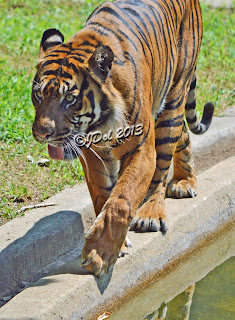This is an adult Orangutan
The oragutans are the two exclusively Asian species of extant great apes. Native to Indonesia and Malaysia, orangutans are currently found in only the rain forests of Borneo and Sumatra. Classified in the genus Pongo, orangutans were considered to be one species. However, since 1996, they have been divided into two species: the Bornean orangutan (P. pygmeus) and the Sumatran orangutan. (P. abelii). In addition, the Bornean species is divided into three subspecies. The orangutans are also the only surviving species of the subfamily Ponginae, which also included several other species, such as Gigantopithecus, the largest known primate. Both species had their genomes sequenced and they appear to have diverged around 400,000 years ago. Orangutans diverged from the rest of the great apes 15.7 to 19.3 million years ago (mya)
Young guy/gal - Too Cute, right?
This is the young Orangutan.
This is an Asian Elephant
The Asian or Asiatic elephant (Elephas maximus) is the only living species of the genus Elephus and is distributed in Southeast Asia from India in the west to Borneo in the east. Asian elephants are the largest living land animals in Asia. Since 1986 E. maximus has been listed as endangered by IUCN as the population has declined by at least 50% over the last three generations, estimated to be 60-75 years. The species is pre-eminently threatened by habitat loss, degradation and fragmentation. In 2003, the wild population was estimated at between 41,410 and 52,345 individuals. Female captive elephants have lived beyond 60 years when kept in semi-natural situations, such as forest camps.
Quite a magnificent African Lion
The lion (Panthera leo) is one of the four big cats in the genus Panthera and a member of the family Felidae. With some males exceeding 250 kg (550 lb), it is the second-largest living cat after the tiger. Wild lions currently exist in sub-Saharan Africa and in Asia, while other types have disappeared from North Africa and Southwest Asia in historic times. The lion is a vulnerable species, having seen a major population decline in its African range of 30-50% per two decades during the second half of the 20th century. Within Africa, the West African lion is particularly endangered. Lions live for 10-14 years in the wild, while in captivity they can live longer than 20 years. In the wild males seldom live longer than 10 years, as injuries sustained from continual fighting with rival males greatly reduce their longevity. Lions are unusually social compared to other cats.
Groups of females lions typically hunt together, preying on large ungulates. Sleeping mainly during the day, lions are primarily nocturnal, although bordering on crepuscular in nature.
But, of course, we have the Bengal Tiger
The Bengal tiger (Pantheras tigris tigris) is the most numerous tiger subspecies. Its populations have been estimated at 1,706-1,909 in India, 440 in Bangladesh, 163-253 in Nepal, and 67-81 in Bhutan. Since 2010, it has been classified as an endangered species by the IUCN. The total population is estimated at fewer than 2,500 individuals with a decreasing trend, and none of the Tiger Conservation Landscapes within the Bengal tiger's range is large enough to support an effective population size of 250 adult individuals.
Well that brings a close to the group of my favorite pix from my National Zoo adventure a couple weeks ago. I hope you enjoyed them and the fun facts about the animals. I would really like to get back and see the pandas. I think I will pop down one Saturday early with just that mission in mind.
This below is a poster I made with a saying that my DH says to me quite often...
Thanks for viewing my photos!
Cheers!
JDol



















No comments:
Post a Comment